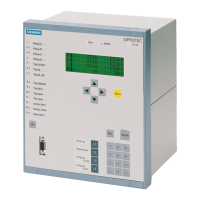2 Functions
130
7SD5 Manual
C53000-G1176-C169-1
be useful (address 1901 PROGAM U/I = LE:Uphe/LL:Uphe), accepting lesser sen-
sitivity for earth-free faults, since the overcurrent stage Iph>> usually picks up there.
In networks with low–resistance earthed starpoint, the U/I/ϕ pickup should only
come into effect on earth faults as phase-to-phase faults are detected by the overcur-
rent pickup. In this case it is reasonable to set address 1901 PROGAM U/I =
LE:Uphe/LL:I>>.
In isolated or resonant-earthed power systems it is possible to control the U/I/ϕ
pickup using phase-to-phase voltages only (address 1901 PROGAM U/I =
LE:Uphp/LL:Uphp). Naturally, this excludes pickup by single earth faults, however,
it also does not allow a correct double earth fault detection, therefore it is suitable only
for small isolated cable networks.
Two further general settings refer to the final times, i.e. the tripping times in a worst
case scenario for faults outside all distance zones. They should be set above the delay
times for distance zones providing a final back-up option (see also configuration of the
function settings for the distance zones in Section 2.5.2.2).
The directional final time DELAY FORW. PU (address 1902) only works with short-
circuits in forward (line) direction if there is no impedance within a distance zone after
pickup.
The non-directional final time DEL. NON-DIR PU (address 1903) works for all faults
if there is no impedance within a distance zone after pickup.
Overcurrent Pickup The maximum operational load current that can occur is crucial for the setting of over-
current pick-up. Pickup due to overload must be ruled out! Therefore the pickup
value Iph>> (address 1910) must be set above the maximum (over-)load current that
is expected (approx. 1.2 times). In this case, it must be ensured that the minimum fault
current is above this value. If this is not the case, U/I pickup is required.
Calculation Example
:
Maximum operational current (incl. overload) is 680 A, for current transformers 600
A/5 A, minimum short circuit is 1200 A. The following settings are made:
Iph>> = I
L max
· 1.2 = 680 A · 1.2 = 816 A
This value is sufficiently below the minimum short-circuit current of 1200 A. When con-
figuring via PC and DIGSI
®
this value can be entered directly as primary value. The
conversion to secondary values is
The condition for minimum short-circuit current also applies to earth faults (in the
earthed network) or for double earth faults as long as overcurrent pickup is solely
used.
U/I(/ϕ) pickup If U/I pickup is required because the minimum short-circuit current is below the
maximum load current (incl. a safety factor of 1.2), the condition for maximum load
current in respect to Iph>> still has to be observed. Then, the minimum current limit
Iph> (address 1911) is set to below the minimum short-circuit current (approx. 10 %).
This also applies to the phase currents during earth faults or double earth faults.
In address 1930 1ph FAULTS you can choose whether a phase-to-earth loop shall
be selected in an earthed network during single-phase pickup without earth current (I
E
release). The setting 1ph FAULTS = PHASE-EARTH is useful if no or only little earth
current can flow via the measuring point in the event of earth faults. With 1ph FAULTS
www . ElectricalPartManuals . com

